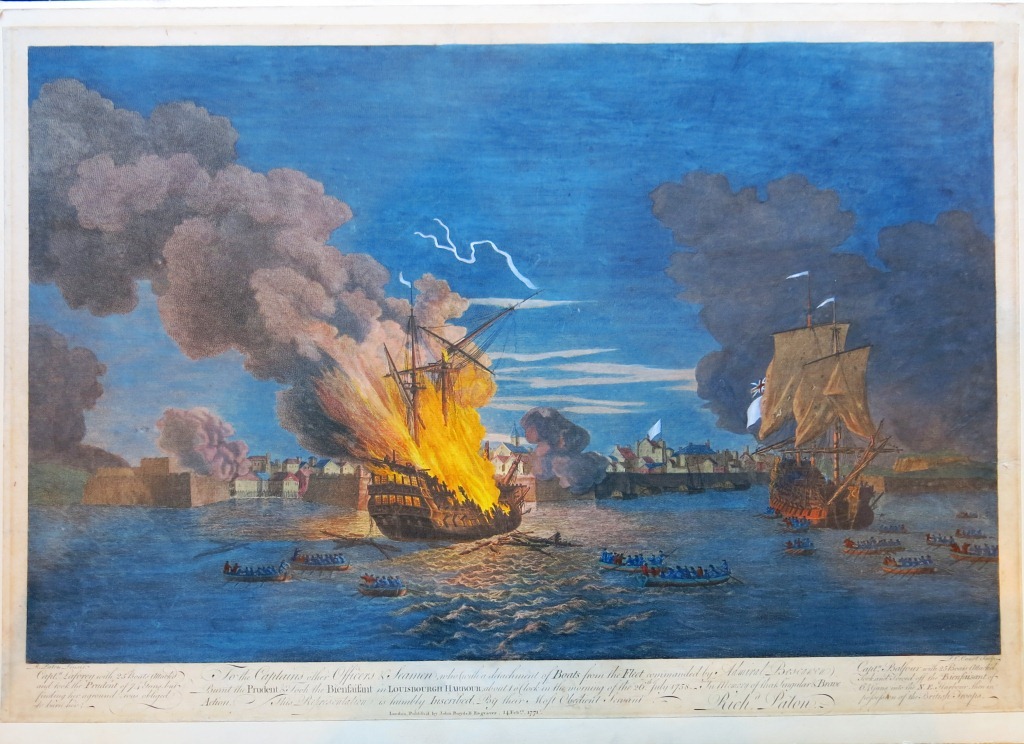By Thomas Lester, Reader Services
During the French and Indian War (1754-1763), the fortified French city of Louisbourg loomed over the Gulf of Saint Lawrence, denying the British access to the Saint Lawrence River – the route to capturing the key cities of Quebec and Montreal. The fortress, considered the “Gibraltar of the North,” had famously been captured by a combination of New England militia and the British navy in 1745, only for the Treaty of Aix-La-Chapelle to return it to the French in 1748. Now, a decade later, the invading British forces looked to capture the fortress for a second time.

In early June 1758, ground forces under the command of Jeffery Amherst landed outside the city and began a siege operation which, in accordance with the standard of 18th century siege warfare, meant digging a network of trenches surrounding the city.
While Amherst’s command toiled in the trenches, the British navy remained concerned about French ships defending the harbor. Though only five French ships of the line remained by late July, they proved enough of a menace to receive considerable attention by way of British artillery fire. As a result, on July 21st, a cannonball penetrated one of the ships, detonating its powder magazine. The ensuing blaze was so hot that it set fire to the sails of two neighboring ships, burning all three down to the waterline.
Three days later, on July 24th, Admiral Edward Boscawen, commander of all British vessels in North America, informed Amherst of his bold plan to capture the remaining two ships – the Prudent (74 guns) and the Bienfaisant (64 guns) . Late in the night of July 25th-26th, two squadrons under the command of Captains John Laforey and George Balfour, totaling approximately 600 sailors and marines, rowed into the harbor. Concealed by the dark and fog, and with Amherst ordering his artillery to “fire into the works as much as possible, to keep the enemy’s attention to the land,” the two squadrons slipped past the French battery guarding the entrance to the harbor and approached the two French vessels undetected.
As Laforey’s command approached the Prudent and Captain Balfour the Bienfaisant, each was hailed by sentries aboard the ships. Receiving no response, the guards opened fire, breaking the silence. The squadrons then moved quickly to maneuver alongside their respective targets, capturing both ships with minimal resistance, but at a cost of sixteen casualties (7 killed, 9 wounded).
Hearing the events that transpired, the French defenders were alerted to the threat and opened fire upon the two ships. Under fire, and finding the Prudent run aground, the British sailors set her ablaze. The Bienfaisant, meanwhile, was towed to the Northeast corner of the harbor, safe from French artillery fire. The image above, printed in 1771, depicts the Prudent caught in a blaze, while nearby the Bienfaisant is towed to safety.
The following day, with Amherst’s ground forces making ready to breach the city walls and Boscawen’s fleet entering the harbor, the French governor sent a messenger to Amherst initiating the surrender of the city.
Discussing the siege, historian Julian Gwyn notes in his book, Frigates and Foremasts, that “some naval and military historians have asserted that once the British assault landing force had succeeded, the capture of the fortress with its garrison was a foregone certainty. Yet none of the British or French accounts expressed this view.” He goes on to comment that “the loss of these two warships had a profound effect on the French defenders…morale plummeted within the town, and the fatigue occasioned by the siege, which until then had been borne without complain, suddenly became unendurable for many.”
In the aftermath of these events, Captain Balfour was awarded with command of the Bienfaisant, and command of the frigate Echo to Captain Laforey. Their lieutenants were also awarded with new commands of their own.
In the short-term, the event depicted was significant for breaking French morale and contributing to the success of the siege. In the long-term it opened the heart of New France, most notably the cities of Quebec and Montreal, to British invasion via the Saint Lawrence River. Having previously read about the events that transpired, I was pleasantly surprised when I stumbled upon this print in our collection. I love the color of the raging fire engulfing the Prudent set against the dark, foggy night with Louisbourg in the background. Most of all I was caught in the suspense while reading about this risky operation.
This print was originally a painting by Richard Paton (1717-1791). Born in London in 1717, Paton was found as a poor boy living on the streets by an admiral of the British navy and went to sea. Receiving no professional training as an artist, Paton is known for depicting the famous sea-battles that occurred during his lifetime. His paintings were exhibited it the Royal Academy of Art in London from 1776-1780.
The engraving was made by Pierre Charles Canot (ca. 1710-1777). Born in France, he moved to England in 1740 where he spent his professional career as an engraver. Most famous for his engravings of Paton’s works, in 1770 he was elected Associate-Engraver of the Royal Academy of Arts in London.

